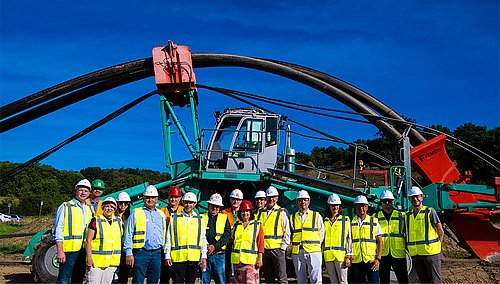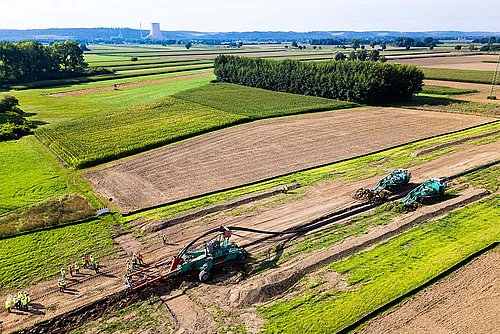This will require the laying of several hundred kilometres of cables. The ploughing method will also be used here – with the help of this modern technology, the cable protection pipes will be laid with as little impact on the ground as possible. On 20th August 2025, the method was presented at the TenneT SOL D3a construction site, on the section between Pfatter and Landshut, in the presence of representatives from politics and the press. Here, ploughing is planned for approximately 28 kilometres of the 45-kilometre section. Currently, approximately ten kilometres of empty conduits have already been ploughed in.
The ploughing process is being carried out by experienced companies from the region. For this purpose, TenneT has commissioned a joint venture consisting of MAX STREICHER GmbH & Co. KG aA (Deggendorf) and Josef Rädlinger Bauunternehmen GmbH (Cham). The plough, which was developed by Walter Föckersperger GmbH, will be operated by SpiderPlow as a subcontractor to the joint venture. The project thus also strengthens regional value creation in Southern Bavaria and intentionally relies on local expertise.
The SuedOstLink is around 700 kilometres long in total, stretching from Klein Rogahn near Schwerin and Wolmirstedt near Magdeburg in Saxony-Anhalt to Isar near Landshut in Bavaria.
Projects of this magnitude often give rise to conflicts of interest, as they frequently cause restrictions, particularly for those living in the immediate area. Local farmers, on the other hand, were actually in favour of the ploughing method, as it produces the lowest CO2, methane and nitrous oxide emissions and protects soil organisms, since there is no mixing of humus and poorer subsoil and thus having only a minor impact on soil fertility. In addition, there are cost savings because the construction corridor is much narrower than with open trench construction and because of the much higher laying speed. The SuedOstLink is scheduled to go into operation in 2027 and 2030, respectively.



